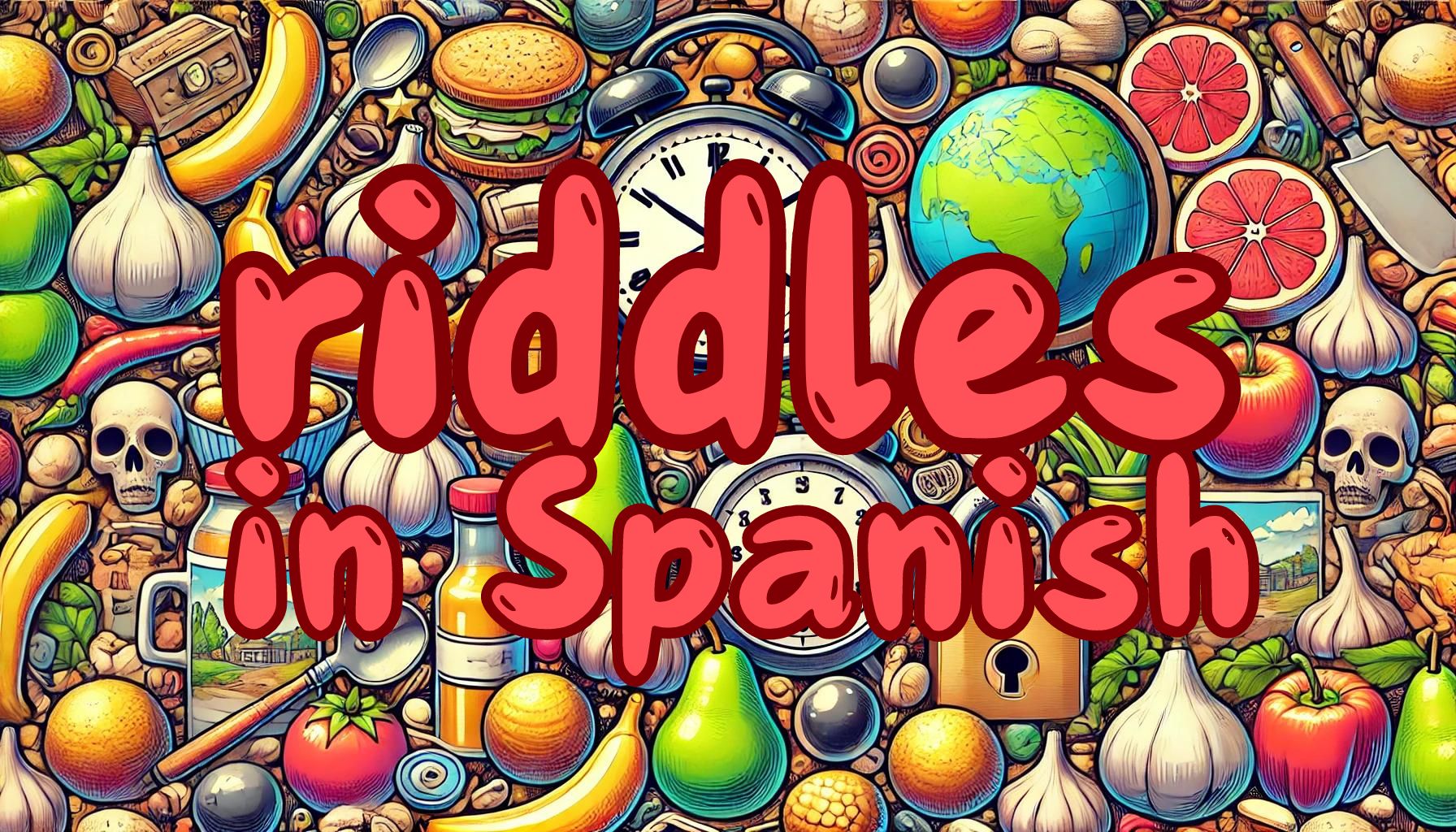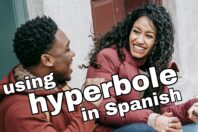Riddles in Spanish: Solve them if you can!

Get our free email course, Shortcut to Conversational.
Have conversations faster, understand people when they speak fast, and other tested tips to learn faster.
More infoRiddles are a fun way to engage the mind and spark curiosity while learning. They not only challenge the brain but also offer a unique chance to dive into cultural and linguistic nuances. Riddles in Spanish are no exception. They mix poetic imagery, wordplay, and cultural references, making them both entertaining and educational.
In this post, we’ll dive into the fascinating world of riddles in Spanish. We’ll present a collection of intriguing Spanish riddles and provide explanations to understand their meanings. Get ready for a mental workout while learning and having fun!
Riddles in Spanish
Las adivinanzas, meaning riddles in Spanish, are questions or enigmas presented in verse or prose. The idea is for the listener to think and scratch their head to guess the correct answer. Generally, riddles use wordplay or metaphors, making them much more exciting and challenging.
With their playful rhymes and clever double meanings, riddles in Spanish are not just brain teasers. They’re a source of fun and laughter, often doubling as jokes.
Verbs used in Spanish riddles often have multiple meanings, making them both challenging and educational to guess and translate. They often include a question to stimulate the brain to think differently, making them an excellent tool for learning Spanish.
We included a few Spanish riddles in our post funny dad jokes in Spanish. Now, it’s time to focus specifically on riddles. Let’s test our brains with these adivinanzas in Spanish!
Riddle this: Not just a fruit – Adivina no es solo una fruta
Here’s a clue, these riddles in Spanish involve food in Spanish and aren’t what they seem. Let’s test your Spanish language skills with these edible riddles.
- Blanca por dentro, verde por fuera. Si no sabes, espera.
- White inside, green outside. If you want me to tell you, wait!
To solve this Spanish riddle, we need to read it out loud and pronounce it slowly. Here’s a hint, it involves the name of a fruit. Still don’t get it? This adivinanza describes a fruit that is white inside and green outside.
The key is to solve it by reading the last word very slowly: espera… es pera. The answer to the riddle is la pera, which is the pear in Spanish. Espera is the imperative form of esperar, meaning to wait. When we pronounce it slowly we say the name of the fruit: es pera. Good one, right?
Here’s our next fruit-related riddle in Spanish:
- Oro parece, plata no es. ¿Qué es?
- It looks like gold, but it’s not silver. What is it?
This one describes something yellow like gold but that’s not a precious metal. It’s similar to the first riddle, in that the key is the intonation, especially in the last part of the statement.
Let’s pronounce it again: Oro parece, plata no es… oro parece, plátano es. The answer is the plantain. The riddle plays on the resemblance of un plátano’s color to gold.
Are you ready for another one?
- Tiene dientes y no come, tiene cabeza y no es hombre. ¿Qué es?
- It has teeth and doesn’t eat, it has a head and isn’t a man. What is it?
Here is a fun riddle that includes body parts, using metaphorical descriptions to refer to an object by describing its parts and what it does not do. It represents an object with teeth and a head that isn’t human.
Perhaps you’re thinking of an animal that fits the description, but with the riddle we’re trying to think of other things that use the same Spanish body part names.
The answer is el ajo, which is garlic in Spanish. Just as you have a head of garlic that’s divided into cloves in English, in Spanish we say la cabeza, meaning the head, when we refer to a full bulb of un ajo, and when we divide it into segments they’re called dientes, meaning teeth. It’s a clever way to use our body parts to name things in Spanish!
Rhyming double-clued riddles: Adivinanzas con doble clave
Let’s continue our brain workout with these double-clued Spanish riddles that will make you scratch your head while thinking.
- Son ocho y todo el mundo los quiere explorar, si quieres saber su nombre tendrás que recordar. ¿Qué son?
- There are eight of them and everyone wants to explore them, if you want to know their names you will have to remember. What are they?
This Spanish riddle takes us back to our school days! Here we need to think about something that is eight in number, and that people are interested in exploring.
Still don’t know what it is? Let’s take a spacecraft and blast off into outer space for this one! The answer is the los planetas, the planets in our solar system.
This adivinanza plays on the universal curiosity about space and the planets in Spanish, encouraging us to think about what comes in a set of eight that people want to learn more about.
Ok, on to our next one:
- Con una manguera, casco y escalera apago los fuegos y las hogueras.
- With a hose, helmet, and ladder, I put out fires and bonfires.
This is another Spanish riddle that our teachers used to say at school. It describes a profession by naming the equipment and tools used in the job.
Need more clues? The hints about the tools and actions are related to firefighting, leading us to our conclusion: the answer is un bombero, which is a firefighter in Spanish.
Ready for another?
- Tengo agujas y no sé coser, tengo números y no sé leer.
- I have needles and I don’t know how to sew, I have numbers and I don’t know how to read.
As with the riddle above, this one talks about an object by naming a couple of its characteristics, while using metaphorical descriptions to highlight that these features are used differently than you might usually think.
Do you need a clue to solve this adivinanza? It’s an object we use to tell the time, whose needles and numbers are not used for sewing or reading. The answer is easy: el reloj, which is the clock. In Spanish, the clock’s hands are known as las agujas, meaning the needles. Los números are the numbers on the clock’s face.
Ok, let’s see one last rhyming riddle in Spanish:
- Chiquito como un ratón y cuida la casa como un león.
- Small like a mouse and guards the house like a lion.
Here we have a riddle that cleverly uses animals in Spanish. Imagine something as tiny as a mouse but with the bravery and ferocity of a lion when it comes to protecting a house. It might not roar or pounce, but it keeps intruders at bay. What can it be? Is it an object or an animal?
Here’s a hint to solve this Spanish riddle: this little hero doesn’t need sharp claws or a mighty roar. All it needs is to fit perfectly into a chain link or some other loop, and can be opened with a key to protect a house.
Still need to figure it out? The answer is el candado, meaning the padlock in Spanish. Think about it: un candado is so tiny that it can fit in a pocket, but still has the power to keep an entire home safe. Again, a clever way to describe an object using a different vocabulary!
Conclusion: Riddles in Spanish
Wow! What a brain workout we had! What do you think? Were these riddles in Spanish challenging for you? Whether they made you scratch your head and keep thinking for a while, or you had a face of amazement after understanding them, we hope you enjoyed and had a few smiles as you explored these Spanish riddles.
Wrapping up our fun dive into riddles in Spanish, it’s clear that these clever puzzles are not just brain teasers; they’re a gateway to learning and enjoying the language.
We’ve explored some common Spanish riddles, translating and explaining each to uncover their meanings. From padlocks guarding homes like lions, to clocks with needles that don’t sew, and even riddles about animals, fruits, and everyday objects, we’ve seen how Spanish speakers use creative imagery and wordplay to challenge and entertain us.
Riddles in Spanish are an excellent way to improve your Spanish skills. They offer a hard-to-beat mix of learning and fun. So keep cracking those riddles, and you’ll be mastering Spanish in no time, one clever puzzle at a time!



